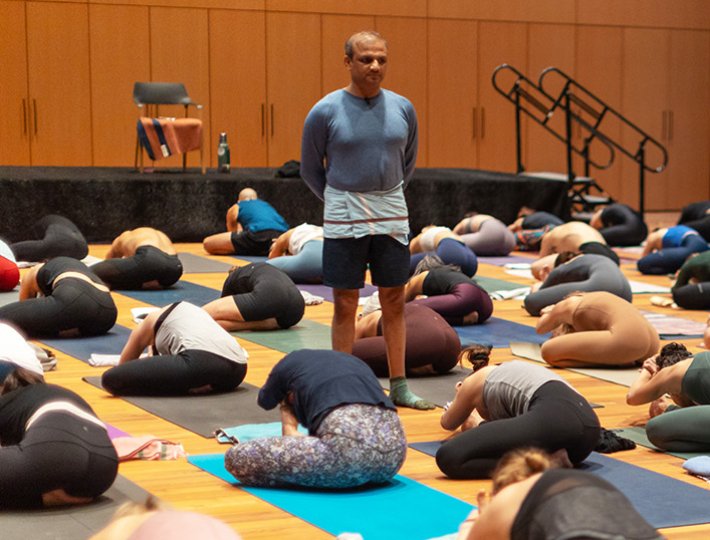When you think massage, the same muscles usually come to mind: the back, the shoulders, the neck; for athletes, the legs. It makes sense. These areas are tension hotspots — and locations where many of us hold our stress. But they’re not the only areas harboring tightness. Here, top experts share which body parts are craving release — plus, how to massage these oft-ignored muscles yourself.
Your Diaphragm
“The average person at rest takes around 23,040 breaths per day,” says Matt Delaney, C.S.C.S., a licensed massage therapist and Tier X Health Coach at Equinox Columbus Circle. “Our diaphragm initiates every single one of them.” That’s not all that this dome-shaped muscle at your ribs does: Along with other core muscles, it helps stabilize your trunk, which is key for efficient, pain-free movement, says Delaney. When there’s dysfunction? You’re susceptible to injury and pain.
Massage it: Sit in a chair and curl the tips of your fingers under your rib cage, says Delaney. Take a deep breath into your belly and on the exhale, flex forward trying to bring your head to your lap; allow your fingers to move further under your ribs. Make sure to exhale fully — this allows the diaphragm to reach its end range under the contact of your fingers. Repeat three to five times.
Your Gut
Many scientists consider the gut the second brain, says Scott Weiss, C.S.C.S., a New York-based physical therapist. That’s because more and more research suggests that a healthy gut (filled with beneficial bacteria) creates a healthy body (and mind). “A mechanical massage aids in moving digestion along,” Weiss says. It also eases muscle tension and relieves air and gas from the system, he says.
Massage it: With firm pressure, make circles to the left on the stomach’s surface. “This circular pattern mimics the normal digestive movements,” says Weiss. Then place one palm on your upper abdomen and overlap it with your other hand (consider this 12 o’clock). Start pressing inward, applying pressure in a clockwise fashion. Slowly go from 12 to 3 to 6 to 9 and back again, he says. This can be done 20 to 30 times with strong, firm pressure.
Your Face and Jaw
Whether you realize it or not, you hold a lot of tension in your face and jaw. Emotions, thoughts, and an internal dialogue can lead you to clench your jaw and facial muscles, says Weiss. “Eating, speaking, and reacting all day can stress these muscles, too.” Yet, most massages leave these stressed out muscles alone.
Massage them: Use the palms of your hands and and pads of the fingertips to apply pressure to the face, forehead, and jaw. Clench you jaw a few times. You’ll find the muscles that need work. Apply pressure where needed. Make your way around the ears, too.
RELATED: 6 Self-Massage Tools to Restore Your Body at Home
Your Thumbs
There are three muscles that sit at the base of your thumb — they make up what’s called the thenar eminence, explains Delaney. And these muscles take a beating all day long as you text and scroll, impacting your grip strength and fine motor control, he says. “It may not sound like a big deal, but grip strength is vital to our longevity,” says Delaney. So much so, in fact, that it’s one of the measurements cardiologists use to predict the outcomes of surgical patients.
Massage them: Start with your thumb flexed into your palm with your palm facing down. With the pointer and middle finger of the other hand, reach under the middle of the palm just below the thenar muscles and draw some tension toward the thumb knuckle. Maintain this tension as you slowly move the thumb away from the palm and allow your fingers to glide up toward its base. Repeat 3 to 5 times per hand.
Your Wrists
In a world of tablets and laptops, your hands and wrist muscles are used more than any other major body part, says Weiss. The best news: Maladies like carpal tunnel syndrome and tendonitis can be kept at bay with some simple massage, he says.
Massage them: Clasp your hands together and make figure eights. Use the prayer position to open and stretch the wrists. Push your fingers to the left and right while together to further stretch the deeper muscles of the wrist, he says.
Your Feet
Most of us take our feet for granted until problems crop up. Here’s why that needs to change: “They are the most dynamic part of our structure,” says Delaney. “Our feet are our first point of contact with the ground and are constantly providing the brain valuable information about where we are.” Plus, a sedentary lifestyle can leave them craving stimulation and too-tight shoes can constrict them, impeding blood flow.
Massage them: Place a golf ball under your foot at the base of the heel, says Delaney. Sitting or standing, trace a line from the front of your heel to each one of the toes and back. Be sure to work across the foot, too, paying special attention to trace the cup of the heel and ball of the foot, he says. Repeat three to five times per foot.












Comments (0)